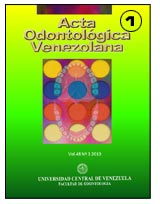ESTUDIO RADIOGRÁFICO DE LAS ALTERACIONES MORFOLÓGICAS DE LA APÓFISIS ESTILOIDE Y DE LA ROTACIÓN DEL CÓNDILO MANDIBULAR EN PACIENTES CON DESORDEN TEMPOROMANDIBULAR
Keywords:
radiología, desordenes temporomandibulares, apófisis estilóide del hueso temporal, radiology, temporomandibular joint disorders, styloid process the temporal boneAbstract
En este estudio se evaluó radiográficamente en pacientes con desorden temporomandibular la posiblerelación entre las alteraciones morfológicas de la apófisis estiloide del hueso temporal y el patrón derotación mandibular. Fueron analizadas 1500 radiografías convencionales de las articulacionestemporomandibulares de los archivos del Servicio-ATM - Facultad de Odontología de la UniversidadFederal de Juiz de Fora. Se observó que 83 pacientes (5,53%) presentaron al menos una de las apófisisestiloide alterada morfológicamente, siendo 9 (10,8%) del sexo masculino y 74 (89,2%) del sexofemenino. La mayoría de los pacientes de este grupo se ubica entre 41 a 50 años de edad (32,5%). Lostipos morfológicos fueron clasificados en normal (13), alargados (113), seudoarticulado (21) ysegmentado (19), totalizando 166 apófisis estiloide. La clasificación de la rotación condilar encontradafue: normal (47), hipomovilidad condilar (30) y hipermovilidad condilar (89), totalizando 166articulaciones temporomandibulares. Por el método estadístico de Cramer`s no fueron verificados indiciosde relación de que las alteraciones morfológicas de la apófisis estiloide pueden interferir en la rotación delcóndilo mandibular ni relación de simetría entre los lados derecho e izquierdo, tanto para el tipomorfológico como para la rotación condilar.
ABSTRACTThe aim of this study was to assess radiographically the possible relations between the morphologicalvariations of the styloid process of the temporal bone and the pattern of the condylar excursions inpatients with temporomandibular disorders. 1500 conventional x-rays of temporomandibular joints wereanalyzed, all of them from the SERVIÇO-ATM-FO/UFJF files. The results show that 83 patients (5.53%)had at least one morphologic variation of the styloid process, among which 09 (10.8%) were male and 74(89.2%) female. Most of these patients are included in the age group of 41 to 50 years (32.5%). Themorphological types were classified as normal (13), elongated (113), pseudoarticulated (21) andsegmented (19), totalizing 166 styloid processes. The classification of the condylar excursion was normal(47), condylar hypomobility (30) and condylar hypermobility (89), which totals 166 temporomandibularjoints. According to Cramer's V statistic method, evidences that styloid process variations may interferein the condylar excursion were not found; there is symmetry between the left and right sides concerningboth morphological type and condylar excursion.

